Environmental experts are to walk the land around key rivers and burns in Angus to check for contamination.
Staff from the Scottish Environment Protection Agency (SEPA) will be walking the South Esk and its tributaries over the next two months, collecting information and assessing the impacts of rural diffuse pollution.
It is a part of ensuring Scotland’s water quality continues to improve and meets quality improvement targets set for 2015.
The South Esk is one of 14 Scottish water catchments that have been prioritised.
Diffuse pollution, often driven by rainfall, results in water contaminated with soil, nutrients, bacteria and chemicals running off land into the environment.
It is a major contributor to poor water quality, which in turn affects the river’s ecology.
The South Esk is home to internationally-important populations of Atlantic salmon and freshwater pearl mussels, both of which can be affected by silt and nutrients put into the river.
Concerns over the productivity of the mussel, in particular, prompted Scottish Natural Heritage (SNH) to run diffuse pollution awareness raising events for land managers in four South Esk sub-catchments.
SEPA has appointed priority catchment officers to co-ordinate work in each area.
Once the walks have been completed, a series of workshops and information events will be arranged to explain the findings to landowners and partner organisations.
Stuart McGowan, unit manager for SEPA’s Dundee and Angus team, said, “The South Esk is an internationally important river system as evidenced by its designation as a Special Area of Conservation, while Montrose Basin is recognised as being internationally important for wildfowl and waders.
“SEPA is now beginning work to tackle rural diffuse pollution within the South Esk catchment.
“The work cannot be completed without help from the community and we need the support of local land managers to deal with the on the ground issues.Working together”This isn’t about SEPA dictating what needs to be done to sort out the problem it’s about working together with the people that live and work in the area, and we are looking for their support in achieving environmental improvements to water quality.
“SEPA is already engaged in partnership work within this catchment via river basin management planning and the South Esk catchment management plan.
“We hope that any land managers meeting our staff walking the catchments during April and May will take the opportunity to tell us about any water issues that concern them.
“SEPA will be taking steps to ensure that we communicate our priority catchment work with all those involved to help us stop rural diffuse pollution being an issue in Angus.”
Barbara Bremner, policy and advice officer with SNH, has welcomed ongoing work to improve water quality.
Jonathan Hall, head of rural policy for NFUS, said managing water quality is as much about land management as everything else put together, with 5.6 million hectares of Scottish land under agricultural management.
It means that Scotland’s farmers carry a huge responsibility to ensure the water environment is of the highest quality in every aspect.
“Clear and concise guidance on measures that can be taken to minimise diffuse water pollution and improve input efficiency will benefit both the water environment and farm business performance, ” he said.
“Tackling the key issues will need a new approach, and this kind of relationship is currently being fostered by SEPA and NFU Scotland working together.”
